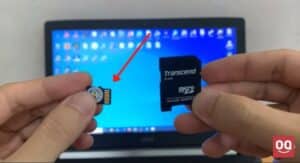Touchpads are often scratched up by accident, which can lead to a number of disadvantages. Due to a scratched touchpad, one of the significant challenges people face is decreased accuracy. This means that you may not be able to move the cursor as accurately as you would like, which can lead to frustration. Another disadvantage is that a scratched touchpad can make your laptop look damaged, even if it’s not.
Moreover, a scratched-up touchpad is unsightly and can also make it difficult to use your laptop. Plus, scratches can cause dirt and other particles to accumulate in the cracks, eventually leading to permanent damage.
If you’re like me, you probably use your laptop’s touchpad all the time. But sometimes, especially after using it for a while, you might notice some scratches on it. And, let’s be honest, no one wants a scratched-up touchpad.
That’s why, in this article, I’m going to show you how to remove scratches from laptop touchpad. So, without further ado, let’s get started.
Here are a few methods to remove scratches from laptop touchpad that you can try:
1. Apply rubbing alcohol
The first thing you should do to remove the scratches is to apply some rubbing alcohol.
Rubbing alcohol, also known as isopropyl alcohol, is a clear, colorless liquid used for various purposes. It can be used as a disinfectant, an antiseptic, and a solvent. Rubbing alcohol can also be used to remove scratches from laptop touchpads.
Take some rubbing alcohol to a clean, soft cloth. Then, gently rub the affected area in a circular motion. You should see the scratches start to disappear. Be sure to use a minimal amount of rubbing alcohol, as too much can damage the touchpad.

Rubbing alcohol is a very affordable solution for removing scratches. You can get rubbing alcohol from your local pharmacy or online stores. You can usually purchase a bottle for just a few dollars. Plus, a little goes a long way, so you won’t need to use much rubbing alcohol to get the job done.
2. Use scratch remover
Another option that you have for removing scratches is to use a scratch remover. A scratch remover is a substance that is used to fill in scratches and make them less visible. If you are dealing with deeper scratches, then using a scratch remover can be a great option.
Apply the scratch remover to the affected area with a microfiber cloth. Rub it in a circular motion. It may take a few minutes to see results. Also, you may need to apply multiple coats of scratch remover, depending on how deep the scratches are.
Also Read: Does Backlit Keyboard Drain Battery?
There are a number of different scratch removers available on the market. You can find them at your local hardware store or online. Be sure to read the instructions carefully before using a scratch remover. Some scratch removers require you to apply a top coat after the scratches have been filled in.
3. Clean with petroleum jelly
Petroleum jelly is a thick, oily substance that is used for a variety of purposes. And surprisingly, it can also be used to remove scratches from laptop touchpads. If you don’t have rubbing alcohol or a scratch remover, you can use petroleum jelly.
It works by filling in the scratches and making them less visible. It’s important to note that petroleum jelly is not a cure-all, and it will not completely remove the scratches. But it can definitely make them less noticeable.
In addition, petroleum jelly is an affordable and easy-to-use solution for removing scratches from your touchpad. Take some petroleum jelly on your finger and rub it on the affected area. After rubbing with your finger, use a soft microfiber cloth to buff the area. You should see the scratches start to fade away.
However, this solution is only effective for touchpads with a matte surface and less effective for glossy laptops.
4. Use metal/plastic polish
Using polish is another way to remove scratches from a laptop touchpad. If you see some minor scratches as well as smudges on your laptop’s touchpad, then it can be a great solution. If your laptop is built of aluminium, then use a metal polish. If it is made of plastic, then use plastic polish.
Before using the polish, clean the touchpad with a soft cloth. Then, apply a little amount of the polish to another soft cloth. Rub the cloth as lightly as you can on the touchpad. You may need to apply pressure to get rid of deeper scratches.
Finally, wipe the touchpad with a clean cloth to remove any residue. And make sure that you don’t use too much polish, as it can damage the touchpad.
Also Read: How to Keep Laptop Speakers Clean?
If you don’t have metal or plastic polish, then you can get it from any hardware store. Alternatively, you can also use an auto polishing compound or rubbing compound.
5. Try using toothpaste
If you’ve tried all of the above methods and none of them has worked, you can try using toothpaste as a last resort. Also, since toothpaste is available in almost every household, it can be a convenient solution.
Wash your hands and remove any dirt or debris from them. This is important as you don’t want to transfer any grime onto the touchpad. Then, squirt a pea-sized amount of toothpaste onto the touchpad. Rub it in using circular motions for about 30 seconds.

When you are done, wipe the touchpad surface using a damp cloth and let it dry. You may need to repeat this process a few times to completely get rid of the scratch.
However, do keep in mind that toothpaste can damage the coating on the touchpad. So, make sure that you use it sparingly and only as a last resort.
How to take care of the laptop touchpad?
Taking care of your laptop’s touchpad is important to prolong the life of your computer. Here are a few tips on how to take care of your touchpad:
1. Avoid using harsh chemicals or abrasive materials when cleaning your touchpad. Instead, use a soft, dry cloth.
2. Be gentle when using the touchpad – avoid using excessive force.
3. If the touchpad becomes wet, do not use it until it is completely dry.
4. Keep the touchpad free of dirt and dust by regularly cleaning it with a soft, dry cloth.
5. If you notice any cracks or damage to the touchpad, stop using it and contact a qualified repair technician.
6 . Be careful not to spill any liquids on the touchpad. If this happens, dry it immediately with a soft cloth.
By following these simple tips, you can help to prolong the life of your laptop’s touchpad. Also, by cleaning the touchpad regularly, you can help to keep it working properly.
Conclusion
So your laptop touchpad has scratches on it. You’re not sure what to do about it, but you don’t want them there. We feel you – scratches can be an eyesore, and they definitely affect the way your device works.
But before you take your laptop to a technician, we have good news for you: those scratches can likely be removed with ease!
In this post, you have learned how to remove scratches from laptop touchpad using five easy and effective methods. You can follow these methods to get rid of those pesky scratches and make your touchpad look as good as new.
We hope that you found this post helpful and that you are now able to remove the scratches from your touchpad with ease. If you have any questions or tips of your own, please share them in the comments below!
Frequently Asked Questions :
Q1: Does water damage the touchpad?
A: Water can damage the touchpad, but it all depends on the severity of the damage. If the touchpad is completely submerged in water, then there is a very high chance that the touchpad will be damaged. However, if the touchpad is only exposed to a small amount of water, then the chances of damage are much lower.
Q2: Is it possible to replace the laptop touchpad?
A: In most cases, it is possible to replace a laptop touchpad. However, there are some laptops where the touchpad is integrated into the palm rest, making it not possible to replace it.
Q3: How much does it cost to replace a laptop touchpad?
A: The cost of replacing a laptop touchpad varies depending on the model of the laptop and the brand of the touchpad. However, in general, replacement touchpads can be found for around $50-$80.
Q4: What are some common symptoms of a damaged touchpad?
A: Some common symptoms of a damaged touchpad include ghost clicks, unresponsive areas, and abnormal cursor behaviour. If you are experiencing any of these symptoms, then it is likely that your touchpad is damaged and needs to be replaced.
Q5: Can the touchpad wear out?
A: Touchpads can wear out over time, but this is typically not a problem unless the touchpad is used excessively. If you find that your touchpad is not working as well as it used to, then it is likely that the touchpad is worn out and needs to be replaced.




![Read more about the article [FIXED] Laptop Stops Charging When Gaming (Updated 2022)](https://technoqia.com/wp-content/uploads/2021/09/LAPTOPS-BATTERY-300x163.jpg)
